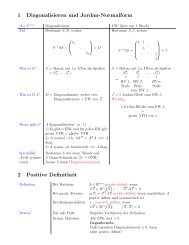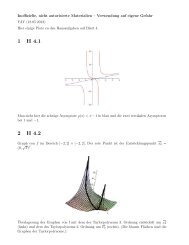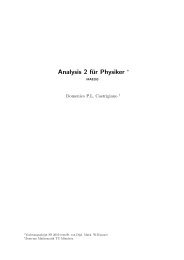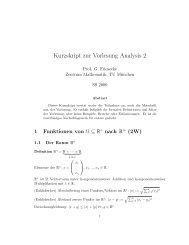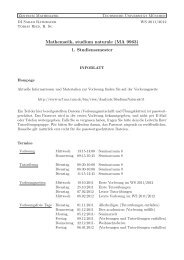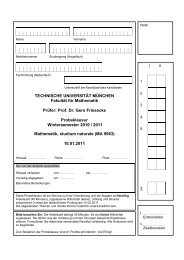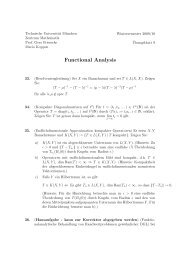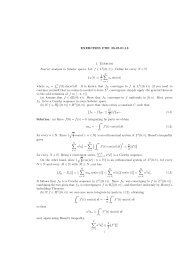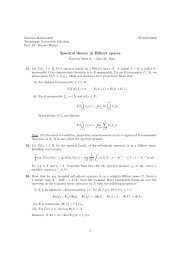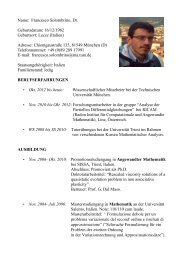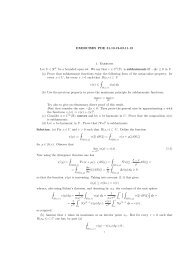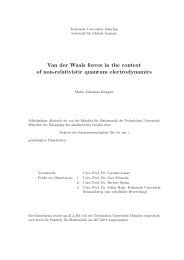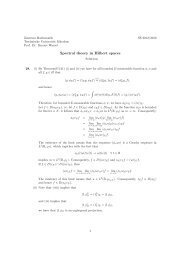Weak Convergence Methods for Nonlinear Partial Differential ...
Weak Convergence Methods for Nonlinear Partial Differential ...
Weak Convergence Methods for Nonlinear Partial Differential ...
Erfolgreiche ePaper selbst erstellen
Machen Sie aus Ihren PDF Publikationen ein blätterbares Flipbook mit unserer einzigartigen Google optimierten e-Paper Software.
We will try to find solutions by first looking at the “singularly perturbed”<br />
system {<br />
∂ t u ε + ∂ x F(u ε ) − ε∂ xx u ε = 0 in R × (0, ∞)<br />
u ε = g on R × {0}.<br />
Physically the term ε∂ xx u ε takes account of (small) viscosity effects. Mathematically<br />
it regularizes the solutions.<br />
The scalar equation in one space dimension:<br />
We now restrict out attention to the special case of a scalar conservation law<br />
in 1 + 1 dimensions. Note that then <strong>for</strong> any convex Φ there exists a Ψ such that<br />
Φ ′ (y) F ′ (y) = Ψ ′ (y) ∀ y ∈ R,<br />
so that (Φ, Ψ) is an entropy/entropy-flux pair.<br />
We follow the approach by L. Tartar. The main ingredient into the existence<br />
proof in the following theorem:<br />
Theorem 3.4 Let Ω ⊂ R 2 be open and bounded, F : R → R in C 1 . Suppose<br />
(u ε ) ⊂ L ∞ (Ω) satisfies<br />
u ε ∗ ⇀ u in L ∞<br />
and that <strong>for</strong> every entropy/entropy-flux pair (Φ, Ψ) there is a compact subset of<br />
W −1,2<br />
loc<br />
containing<br />
∂ t Φ(u ε ) + ∂ x Ψ(u ε )<br />
<strong>for</strong> every ε > 0. Then<br />
F(u ε ) ∗ ⇀ F(u) in L ∞ ,<br />
F ′ (u ε ) → F ′ (u)<br />
in L p ∀ p < ∞<br />
and moreover, if there is no interval on which F is affine, then even<br />
F(u ε ) ∗ ⇀ F(u) in L p ∀ p < ∞.<br />
Proof. Fix an entropy/entropy-flux pair (Φ, Ψ) and consider the bounded sequence<br />
(u ε , v ε , w ε , z ε ) := (u ε , F(u ε ), Φ(u ε ), Ψ(u ε )) ∈ L ∞ (Ω; R 4 ).<br />
Passing to a subsequence we have<br />
(u ε , v ε , w ε , z ε ) ∗ ⇀ (u, v, w, z) in L ∞ (Ω; R 4 )<br />
<strong>for</strong> suitable u, v, w, z ∈ L ∞ (Ω).<br />
In order to prove the first assertion, namely, F(u ε ) ∗ ⇀ F(u), it thus remains<br />
to be seen that v = F(u) a.e.<br />
63



